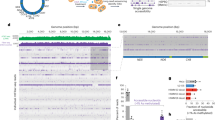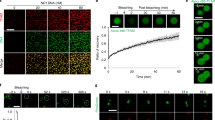Abstract
Nuclear DNA is tightly packed into nucleosomal structure. In con-trast, human mitochondrial DNA (mtDNA) had long been believed to be rather naked because mitochondria lack histone. Mitochondrial transcription factor A (TFAM), a member of a high mobility group (HMG) protein family and a first-identified mitochondrial transcription factor, is essential for maintenance of mitochondrial DNA. Abf2, a yeast counterpart of human TFAM, is abun-dant enough to cover the whole region of mtDNA and to play a histone-like role in mitochondria. Human TFAM is indeed as abundant as Abf2, suggesting that TFAM also has a histone-like architectural role for maintenance of mtDNA. When human mitochondria are solubilized with non-ionic detergent Nonidet-P40 and then separated into soluble and particulate fractions, most TFAM is recovered from the particulate fraction together with mtDNA, suggesting that human mtDNA forms a nucleoid structure. TFAM is tightly associated with mtDNA as a main component of the nucleoid.
Access this chapter
Tax calculation will be finalised at checkout
Purchases are for personal use only
Preview
Unable to display preview. Download preview PDF.
Similar content being viewed by others
References
Kang, D. & N. Hamasaki. 2002. Maintenance of mitochondrial DNA integrity: repair and degradation. Curr. Genet. 41: 311–322.
Fisher, R.P. & D.A. Clayton. 1988. Purification and characterization of human mitochondrial transcription factor 1. Mol. Cell. Biol. 8: 3496–3509.
Parisi, M.A. et al. 1993. A human mitochondrial transcription activator can functionally replace a yeast mitochondrial HMG-box protein both in vivo and in vitro. Mol. Cell. Biol. 13: 1951–1961.
Falkenberg, M. et al. 2002. Mitochondrial transcription factors B1 and B2 activate transcription of human mtDNA. Nat. Genet. 31: 289–294.
Shadel, G.S. & D.A. Clayton. 1997. Mitochondrial DNA maintenance in vertebrates. Annu. Rev. Biochem. 66: 409–435.
Larsson, N.G. et al. 1998. Mitochondrial transcription factor A is necessary for mtDNA maintenance and embryogenesis in mice. Nat. Genet. 18: 231–236.
Bustin, M. 1999. Regulation of DNA-dependent activities by the functional motifs of the high-mobility-group chromosomal proteins. Mol. Cell. Biol. 19: 5237–5246.
Wolffe, A.P. 1994. Architectural transcription factors. Science 264: 1100–1103.
Wolffe, A.P. 1999. Architectural regulations and HMG1. Nat. Genet. 22: 215–217.
Diffley, J.F.X. & B. Stillman. 1992. DNA binding properties of an HMGl-related protein from yeast mitochondria. J. Biol. Chem. 267: 3368–3374.
Diffley, J.F.X. & B. Stillman. 1991. A close relative of the nuclear, chromosomal high-mobility group protein HMG1 in yeast mitochondria. Proc. Natl. Acad. Sci. USA 88: 7864–7868.
Megraw, T.L. & C.B. Chae. 1993. Functional complementarity between the HMG-like yeast mitochondrial histone HM and bacterial histone-like protein HU. J. Biol. Chem. 268: 12758–12763.
Miyakawa, I. et al. 1987. Isolation of morphologically intact mitochondrial nucleoids from the yeast, Saccharomyces cerevisiae. J. Cell Sci. 88: 431–439.
Sasaki, N. et al. 1998. DNA synthesis in isolated mitochondrial nucleoids from plasmodia of Physarum polycephalum. Protoplasma 203: 221–231.
Satoh, M. & T. Kuroiwa. 1991. Organization of multiple nucleoids and DNA molecules in mitochondria of a human cell. Exp. Cell Res. 196: 137–140.
Spelbrink, J.N. et al. 2001 Human mitochondrial DNA deletions associated with mutations in the gene encoding Twinkle, a phage T7 gene 4-like protein localized in mitochondria. Nat. Genet. 28: 223–231.
Garrido, N. et al. 2003. Composition and dynamics of human mitochondrial nucleoids. Mol. Biol. Cell. 14: 1583–1596.
Alam, T.I. et al. 2003. Human mitochondrial DNA is packaged with TEAM. Nucleic Acids Res. 31: 1640–1645.
Takamatsu, C. et al. 2002. Regulation of mitochondrial D-loops by transcription factor A and single-stranded DNA-binding protein. EMBO Rep. 3: 451–456.
Clayton, D.A. 1991. Replication and transcription of vertebrate mitochondrial DNA. Annu. Rev. Cell Biol. 7: 453–478.
Fisher, R.P. et al. 1991. A rapid, efficient method for purifying DNA-binding proteins. J. Biol. Chem. 266: 9153–9160.
Ohno, T. et al. 2000. Binding of human mitochondrial transcription factor A, an HMG box protein, to a four-way DNA junction. Biochem. Biophys. Res. Commun. 271: 492–498.
Williams, R.S. 1986. Mitochondrial gene expression in mammalian striated muscle. J. Biol. Chem. 261: 12390–12394.
Goto, A. et al. 2001. Drosophila mitochondrial transcription factor A (d-TFAM) is dispensable for the transcription of mitochondrial DNA in Kcl 67 cells. Biochem. J. 354: 243–248.
Nam, S.C. & C. Kang. 2001. Expression of cloned cDNA for the human mitochondrial RNA polymerase in Escherichia coli and purification. Protein Expr. Purif. 21: 485–491.
Prieto-Martin, A. et al. 2001 A study on the human mitochondrial RNA polymerase activity points to existence of a transcription factor B-like protein. FEBS Lett. 503: 51–55.
McCulloch, V. et al. 2002. A human mitochondrial transcription factor is related to RNA adenine methyltransferases and binds S-adenosylmethionine. Mol. Cell. Biol. 22: 1116–1125.
Jackson, D.A. et al. 1996. Sequences attaching loops of nuclear and mitochondrial DNA to underlying structures in human cells: the role of transcription units. Nucleic Acids Res. 24: 1212–1219.
Getzenberg, R.H. et al. 1991. Nuclear structure and the three-dimensional organization of DNA. J. Cell. Biochem. 47: 289–299.
Brown, D.A. & J.K. Rose. 1992 Sorting of GPI-anchored proteins to glycolipid-enriched membrane subdomains during transport to the apical cell surface. Cell 68: 533–544.
Yaffe, M.P. 1999. The machinery of mitochondrial inheritance and behavior. Science 283: 1493–1497.
Carre, M. et al. 2002. Tubulin is an inherent component of mitochondrial membranes that interacts with the voltage-dependent anion channel. J. Biol. Chem. 277: 33664–33669.
Tolstonog, G.V. et al. 2001. Isolation of SDS-stable complexes of the intermediate filament protein vimentin with repetitive, mobile, nuclear matrix attachment region, and mitochondrial DNA sequence elements from cultured mouse and human fibroblasts. DNA Cell Biol. 20: 531–554.
Herrmann, H. & U. Aebi. 2000. Intermediate filaments and their associates: multi-talented structural elements specifying cytoarchitecture and cytodynamics. Curr. Opin. Cell. Biol. 12: 79–90.
Kubota, T. et al. 1997. Cardiac-specific overexpression of tumor necrosis factor-alpha causes lethal myocarditis in transgenic mice. J. Card. Fail. 3: 117–124.
Author information
Authors and Affiliations
Corresponding author
Editor information
Rights and permissions
Copyright information
© 2004 Springer-Verlag Berlin Heidelberg
About this chapter
Cite this chapter
Kanki, T. et al. (2004). Mitochondrial Nucleoid and Transcription Factor A. In: Lee, H.K., DiMauro, S., Tanaka, M., Wei, YH. (eds) Mitochondrial Pathogenesis. Annals of the New York Academy of Sciences, vol 1011. Springer, Berlin, Heidelberg. https://doi.org/10.1007/978-3-662-41088-2_7
Download citation
DOI: https://doi.org/10.1007/978-3-662-41088-2_7
Publisher Name: Springer, Berlin, Heidelberg
Print ISBN: 978-1-57331-491-6
Online ISBN: 978-3-662-41088-2
eBook Packages: Springer Book Archive




